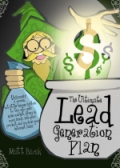How To Market A Seminar
How To Market A Seminar
Have you ever left a seminar thinking: “I could have done a better job than that!” Before you start signing up attendees, take a few minutes to think about what you are getting into. Putting on a seminar involves planning, time, and money. Understanding the ins and outs of the industry will go a long way in helping you hold a successful seminar. That’s where I come in. Over the past 4 years, I have put on over 4,000 seminars, and a handful of national conventions. I will help you plan the event, and make sure that someone shows up!
The first thing that you need to consider is your purpose for holding the seminar. Are you trying to make money on ticket sales? Or money after the class? Are you just trying to get people in the door? Your goal of the seminar will play a huge role in the marketing method that you choose. Don’t be afraid to think outside of the box here. Many companies will try to make the most money possible on all fronts. This greedy train of thought will leave your seminar lacking some very important elements. Choose one and stick with it. Many seminar gurus know that the real money in the seminar business is in the after class sales. This could be follow-up work from your instructor, a subsequent training seminar, an add-on product, etc. You want everyone to leave with something in their hand.
Now that you have your goal set, its time to put butts in chairs! Don’t let anyone fool you into thinking that a successful seminar has to cost a lot of money. If your overall goal is to get after the class sales, or fill up a room consider some of these options:
No matter what method you choose, try to get your campaign rolling 2-3 weeks prior to the seminar. The marketing pieces should be in their hands within that time, anything before or after will likely go unnoticed.
Now that you have attendees, you need to focus on the seminar itself. There are many barriers to adult learning, but they are easy to overcome. The main one that I have come across has to do with the format of the class. You want to create an environment that will encourage teamwork and participation. The instructor plays a huge role in the overall feel of the seminar. They need to guide the students to the right answers, allowing them to try to find the answers in their workbooks or among each other. When creating a workbook, keep the sentences short and to the point. Avoid grammatical errors and long drawn out paragraphs. When possible, use bullet points to break up large amounts of data. If the subject warrants it, add plenty of graphics or screenshots. Over 65% of the general population is visual learners, so make sure to give them plenty to see.
Last but not least, focus on the seminar itself. Don’t get caught up in catered lunches or complex setups. Offer tea and coffee and plenty of breaks throughout the day. They are there to learn and hopefully give you their money, the rest is just details!
Marketing Tips Provided to You by:
Matt Bacak, The Powerful Promoter
Author of Powerful Promoting Tips
Have you ever left a seminar thinking: “I could have done a better job than that!” Before you start signing up attendees, take a few minutes to think about what you are getting into. Putting on a seminar involves planning, time, and money. Understanding the ins and outs of the industry will go a long way in helping you hold a successful seminar. That’s where I come in. Over the past 4 years, I have put on over 4,000 seminars, and a handful of national conventions. I will help you plan the event, and make sure that someone shows up!
The first thing that you need to consider is your purpose for holding the seminar. Are you trying to make money on ticket sales? Or money after the class? Are you just trying to get people in the door? Your goal of the seminar will play a huge role in the marketing method that you choose. Don’t be afraid to think outside of the box here. Many companies will try to make the most money possible on all fronts. This greedy train of thought will leave your seminar lacking some very important elements. Choose one and stick with it. Many seminar gurus know that the real money in the seminar business is in the after class sales. This could be follow-up work from your instructor, a subsequent training seminar, an add-on product, etc. You want everyone to leave with something in their hand.
Now that you have your goal set, its time to put butts in chairs! Don’t let anyone fool you into thinking that a successful seminar has to cost a lot of money. If your overall goal is to get after the class sales, or fill up a room consider some of these options:
- Give it away! It’s a radical idea, but one that I have grown to know and love. By offering the class for free, you eliminate many of the barriers to the sale. Price is not an issue, and they will expect less from you. That doesn’t mean that you should skimp on content, but their expectations will be considerably lower. If you have the resources and time, consider making a pre-seminar call to touch base with everyone that is signed up. This will encourage the students to show up on time, and help built a relationship for future sales.
- Submit a press release. Create a simple press release (1 page or less) highlighting your company and your seminar. Don’t forget to include your registration phone number. Submit that release to your local paper, and wait for the phone to ring. If the paper decides to pick it up- you get free publicity!
- Cross-marketing opportunities. Depending on the seminar, you may be able to find cross marketing opportunities. For instance, if you were doing a financial based seminar teaching students how to file their taxes, you could pair up with a local tax preparation office or accountant. They could pick up half of the marketing tab, or advertise to their existing client base. The possibilities are endless. I have had some great results by pairing with the local chamber of commerce or bank chains. They will offer their seminar space for free, and help with free advertising.
- Local paper. Get a price quote from your local paper. Small town publications will usually cost less than $500 dollars, while metropolitan areas can run as much as $2000.
- Mailers. Direct mail is always a popular choice, but tends to cost a bit more to execute. Consider forgoing the expensive four color brochure in place of a targeted letter, hand signed. They cost a lot less to reproduce and tend to draw more attention than a mass mailer. Postcards are also an inexpensive way to reach a large group of people. Consider sending your mailers to pre-existing customers or you can buy a targeted mailing list from companies like http://www.infousa.com/.
No matter what method you choose, try to get your campaign rolling 2-3 weeks prior to the seminar. The marketing pieces should be in their hands within that time, anything before or after will likely go unnoticed.
Now that you have attendees, you need to focus on the seminar itself. There are many barriers to adult learning, but they are easy to overcome. The main one that I have come across has to do with the format of the class. You want to create an environment that will encourage teamwork and participation. The instructor plays a huge role in the overall feel of the seminar. They need to guide the students to the right answers, allowing them to try to find the answers in their workbooks or among each other. When creating a workbook, keep the sentences short and to the point. Avoid grammatical errors and long drawn out paragraphs. When possible, use bullet points to break up large amounts of data. If the subject warrants it, add plenty of graphics or screenshots. Over 65% of the general population is visual learners, so make sure to give them plenty to see.
Last but not least, focus on the seminar itself. Don’t get caught up in catered lunches or complex setups. Offer tea and coffee and plenty of breaks throughout the day. They are there to learn and hopefully give you their money, the rest is just details!
Marketing Tips Provided to You by:
Matt Bacak, The Powerful Promoter
Author of Powerful Promoting Tips





















































































<< Home